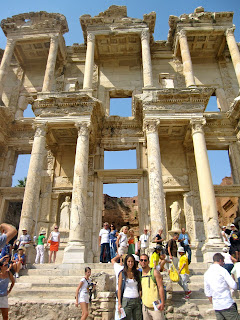I am doing great and still loving being in Turkey. For all of you who contacted me concerned about my safety after the earthquake, thank you. I am fine! Istanbul is about 800 miles away from where the earthquake hit near Van, so I didn't even feel anything.
The earthquake was a measured at 7.2-magnitude and so far 535 people have died and 2,300 people were injured. Rescue crews are still searching for survivors. Yesterday, they found an 18-year old boy 100 hours after the earthquake. Check it out: http://www.cnn.com/2011/10/27/world/europe/turkey-quake/index.html?hpt=wo_c1.
Although I am in Turkey, I haven't felt like the country is recovering from a natural disaster. Apart from what I've been reading on CNN, The New York Times, and Hürriyet Daily News, I haven't heard much about the earthquake here. Even in class professors haven't mentioned it. It reminds me of what my brother Miles said about being in Japan during the earthquake. He too was in a town far away from where the earthquake hit. The people of Istanbul are going about their everyday lives, seemingly unaffected.
However, what has been affecting the people of Istanbul is the Kurdistan Worker's Party, or PKK, attack on Turkish soldiers on October 19th. The outlawed PKK killed 24 soldiers in eight simultaneous attacks in the Kazan Valley in the border district of Çukurca. The PKK is a Kurdish organization which has been fighting an armed struggle against Turkey since 1984 for an autonomous Kurdistan and greater rights for the Kurds in Turkey. The PKK is recognized as a terrorist organization by the US and EU. The issue of Kurdish nationalism in Turkey is especially important right now in light of Turkey's public support for an independent Palestine.
On October 19th and in the days that followed, there were rallies and protests all over the streets of Istanbul. I was in Taksim Square on October 19th to see a jazz concert, and there was a large group of Turkish people marching down Istiklal Avenue waving Turkish flags and chanting words that I could not understand, but could only guess were nationalist sentiments. Later that night, my friends and I saw hundreds of yellow taxis driving together through the streets honking and also waving Turkish flags.
With all that said, Turkey's media is censored and it is difficult to discern the truth. Some have said the PKK killed much more Turkish soldiers than government officials have reported. I am not sure what to believe. All I know is that I hope the Turkish government isn't reading my blog...





































